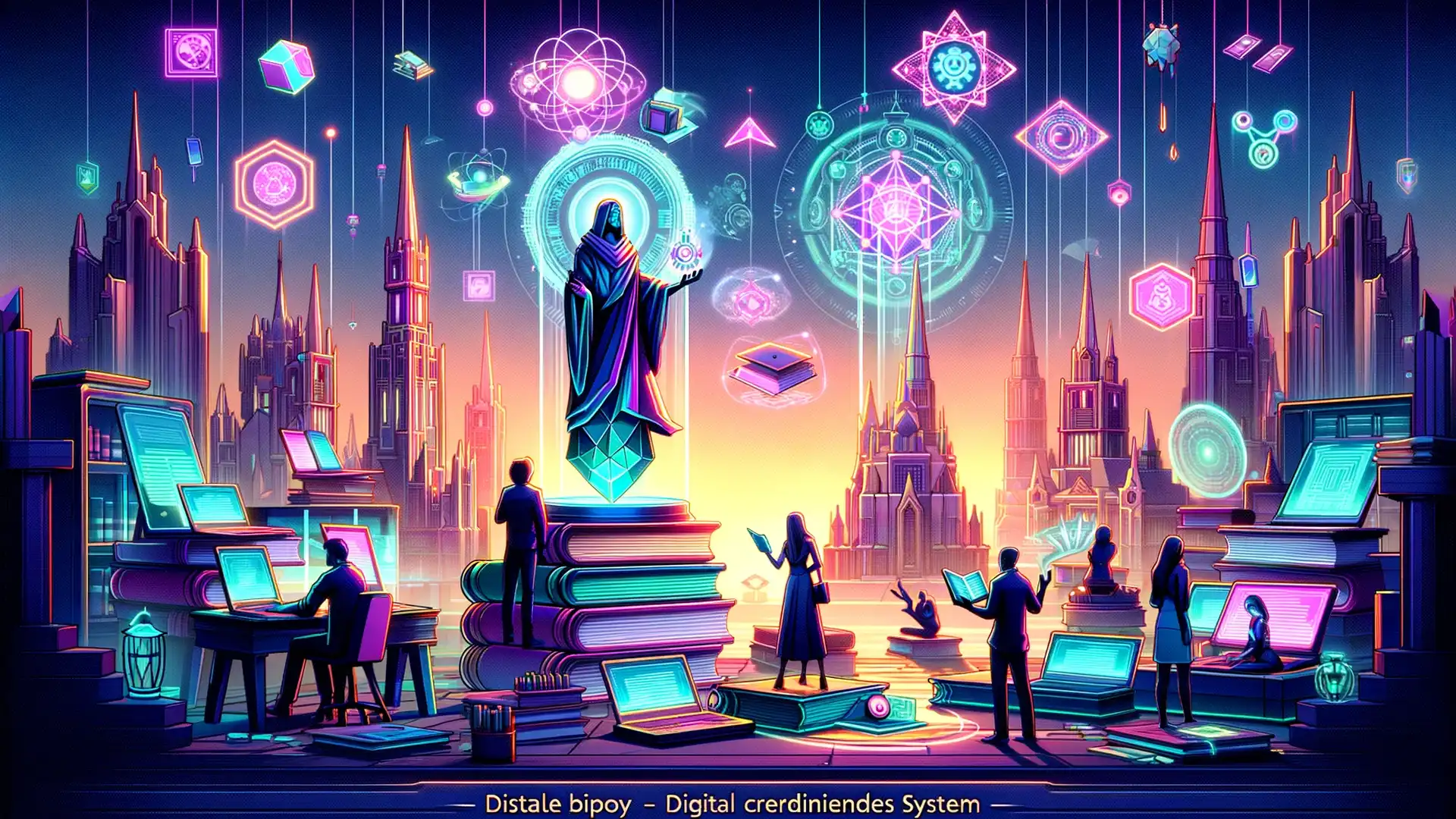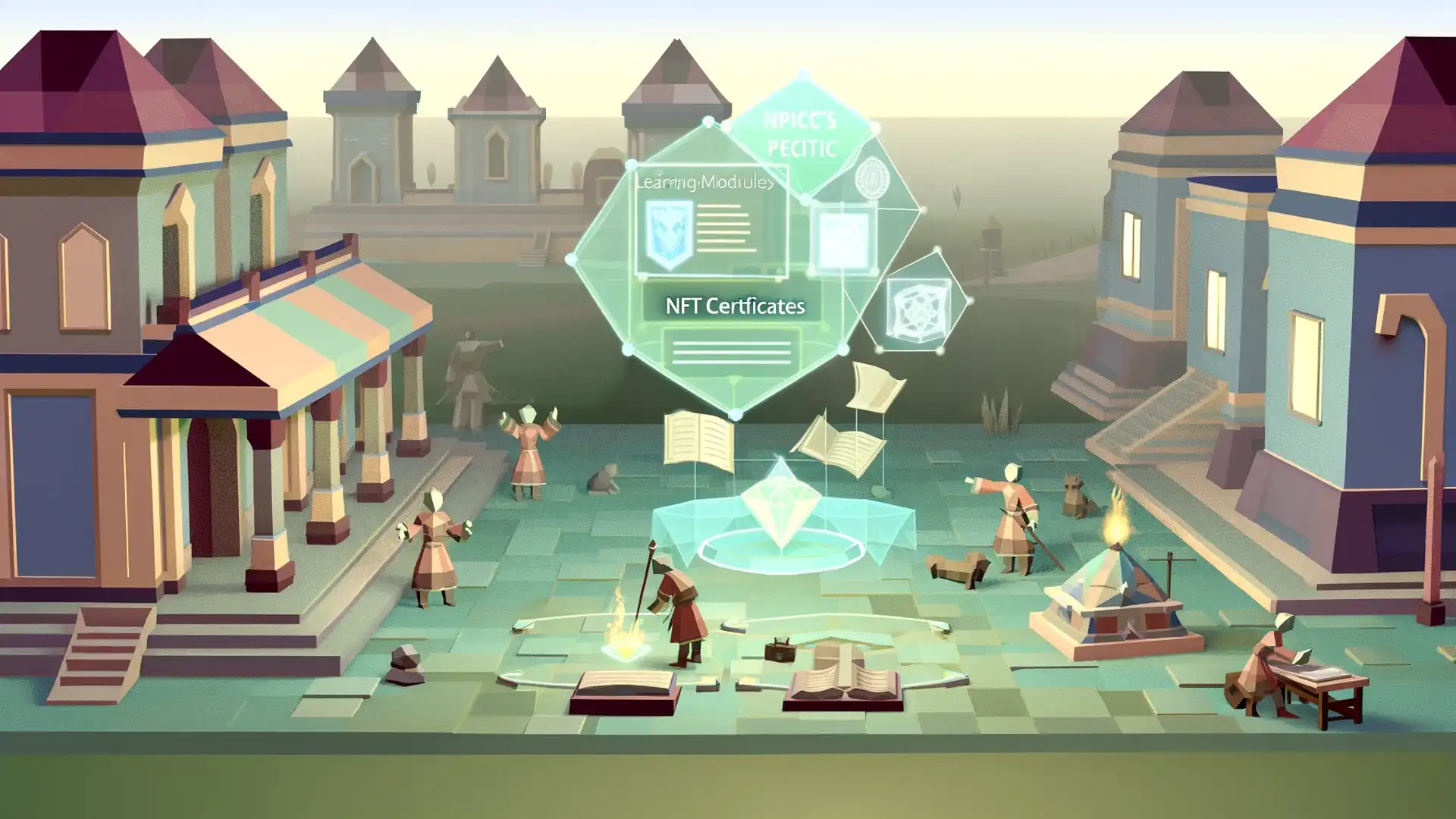Developing a Curriculum Using NFT Credentials and Blockchain

 Author:
Artem Grigoriev
Author:
Artem Grigoriev
Harnessing Blockchain in Education: Foundations and Applications
Imagine a world where your academic records follow you effortlessly throughout your life . They are accessible with a simple click and instantly verifiable. This is not a future scenario but a present possibility with blockchain technology . This technology is a secure, decentralized system that records data across numerous computers. It has been integrated into education through NFT credentials . These credentials are digital certificates that are unique and secure because of blockchain technology.
📘 This article complements: "The Complete Guide to NFT Credentials". Explore it to find answers to all your questions;)
This chapter delves into the transformative role of blockchain in education. It revolutionizes the sector by offering a secure, transparent, and immutable system for credentialing . Blockchain creates an "infrastructure of trust," essential in digital certification. It enables the seamless transfer and verification of credentials without intermediaries, such as schools or government agencies. Benefits of Blockchain in Education
At the heart of blockchain's appeal is its decentralized nature . Data is not stored in one central location but distributed across a network of computers. Unlike traditional systems where a single entity controls the data, blockchain disperses it across many locations. This makes it nearly impossible to alter any information once it’s recorded. This feature is invaluable in education where the integrity of credential verification is critical. It maintains both integrity and trust.
In this context, blockchain serves not just as a technology but as a new approach in educational governance . It provides a model where the power of educational accreditation is distributed among various stakeholders. This reduces vulnerability to tampering and corruption, and thus enhances the system’s credibility.
NFTs , or Non-Fungible Tokens, represent the next evolution in digital certification. These tokens are unique, non-interchangeable units of data stored on a blockchain. They represent a range of items, including educational credentials. NFTs provide a permanent, tamper-proof record of academic achievements. They are akin to unique digital certificates that cannot be duplicated. Imagine proving your degree, certifications, or workshop completions without needing to contact your alma mater or training providers. The Blockchain Research Institute discusses how NFTs allow for the tokenization of academic credentials . This reduces the risk of counterfeit diplomas and improves learner mobility in the global education market. Understanding NFTs in Academia
The benefits of using blockchain and NFTs in education include: - Enhanced Security and Transparency: Every transaction is recorded on a blockchain. This creates a permanent and unalterable history. - Sustainability of Records: Digital credentials do not degrade or get lost. They remain accessible and verifiable from anywhere in the world. - Decentralization: This reduces reliance on central authorities. It lowers the risk of fraud and errors.
💡 Note: Blockchain technology in education goes beyond just credentialing. It supports more personalized and flexible learning paths. It aids the accumulation and transfer of educational credits in ways traditional transcripts and records cannot. These systems also promote lifelong learning, making it easier for individuals to accumulate and provide evidence of ongoing education and professional development.

For educators and institutions ready to embrace these technologies, understanding the underlying principles and technological requirements is crucial. Implementing blockchain in education requires a robust IT infrastructure. This encompasses computer and network systems. It also requires a shift in mindset to appreciate the decentralization of control over credentialing.
Educators need to be well-versed in blockchain operations. This ensures its smooth integration into educational practices.
This chapter also looks at real-world applications where institutions have successfully integrated blockchain and NFT systems. For instance, the Massachusetts Institute of Technology (MIT) has been a leader by issuing digital diplomas that utilize blockchain's security and permanence. These credentials can be verified anywhere at any time. This highlights not only the practicality but also the growing acceptance of blockchain in respected academic settings. According to a study by the European Commission , initiatives like MIT's are paving the way for broader adoption of blockchain technology in educational institutions worldwide . This enhances academic mobility and recognition. European Commission on Blockchain in Education
The potential for blockchain to transform traditional educational models is substantial. It promises a future where learning is more personalized, achievements are immediately recognizable, and educational credentials are universally trusted and easily shared. Blockchain technology can greatly reduce the bureaucratic overhead in educational transactions and record-keeping. This makes education more accessible and equitable globally.
As we explore these possibilities, it's evident that blockchain could fundamentally change how we approach education and professional development. This shift is not just about technological innovation but also about creating a more inclusive and accessible framework for recognizing and transferring knowledge and skills.
💡 Tip: Institutions considering blockchain for credentialing should start with pilot projects. Focus on specific programs or credentials to assess the impact and refine the system before a full-scale rollout. This strategy minimizes risk and allows for the adaptation of technology to specific educational needs and contexts. This facilitates a better understanding of blockchain's nuances and how to tailor its deployment to meet the diverse needs of learners.

Strategic Implementation and Future Prospects of Blockchain in Education
The integration of blockchain technology in education signifies more than just a technological upgrade. It marks a profound shift in how educational credentials are managed, issued, and verified. This chapter provides a strategic roadmap for the implementation of blockchain and NFT credentials . These are digital certificates that are secured and managed using blockchain technology. It details the significant benefits and also tackles the inherent challenges and complexities.
Deloitte’s 2020 report on blockchain in education suggests that this technology can streamline operations and potentially reduce administrative costs. This efficiency can make educational systems more focused on student needs and more efficient overall. Deloitte Insights on Blockchain
Blockchain technology bolsters security by guarding against unauthorized access and ensures transparency with clear visibility into the system's operations and transactions. This enables the permanent verification of credentials . These features make blockchain an attractive solution for educational institutions. They ensure that academic records are secure from tampering, easily accessible, and verifiable. This is crucial in an increasingly digital and globalized educational landscape.
By operating on a decentralized platform without central control, blockchain reduces risks such as data breaches and fraud. These are vital for maintaining the authenticity of academic records and safeguarding personal data. Additionally, blockchain enables real-time verification of credentials. This can significantly accelerate background checks and simplify admissions processes in both educational and professional settings.
The decentralized platform distributes the management and storage of records across multiple locations. This reduces the risk of centralized data manipulation or loss.
However, adopting this technology is not without challenges. Key hurdles include the technological complexity of blockchain systems and the requirement for digital literacy . The skills and knowledge necessary to effectively use digital technologies are essential among educators and students.
There is a significant learning curve involved in understanding and utilizing blockchain. This can inhibit its widespread adoption. The World Economic Forum reports that developing a comprehensive blockchain infrastructure necessitates technical expertise. It also requires strategic partnerships between academic institutions, technology providers, and regulatory bodies. Such partnerships are crucial for creating an environment conducive to digital transformation. World Economic Forum’s Blockchain Education
💡 Note: It is crucial to carefully navigate legal and ethical considerations when implementing blockchain in education. Issues such as data privacy and the ethical management of student information are fundamental and essential. They are necessary for maintaining trust and complying with educational standards and regulations.

This chapter also showcases case studies from institutions that have pioneered the use of blockchain in education. An example is the University of Nicosia in Cyprus, which was among the first to issue blockchain-based digital diplomas. These case studies provide practical insights and proven strategies. They highlight the benefits of blockchain in enhancing student mobility and job market readiness through verifiable digital certificates and badges.
This pioneering effort has established a precedent. It demonstrates the viability of blockchain for issuing secure and internationally recognized credentials. It encourages other institutions to explore the potential of blockchain.
Looking forward, the chapter discusses the future prospects and emerging trends of blockchain technology in education. Innovations such as smart contracts —automated agreements encoded on a blockchain—and decentralized autonomous organizations (DAOs) —community-led entities with no central authority, governed by rules encoded on a blockchain—are set to further revolutionize educational administration and learning experiences.
Smart contracts can automate many administrative tasks, such as issuing certificates and collecting tuition fees. This potentially reduces overhead costs and enhances efficiency. The adoption of DAOs could transform governance models in educational institutions. It makes them more democratic and responsive to community needs. These advancements are steering educational experiences toward more interactive and participant-driven environments. Here, stakeholders have greater control and influence.
Educators interested in integrating blockchain into their curricula will find practical advice on designing blockchain-based courses. They will learn how to integrate NFT credentials and develop innovative assessment methods. These strategies leverage the unique capabilities of blockchain to validate and motivate student learning. They ensure that educational achievements are recognized and transferable across borders and institutions.
IEEE’s guide on blockchain in education emphasizes the need for curricular reforms. These include essential blockchain literacy, preparing students for a future dominated by digital credentials. IEEE on Blockchain in Education
The chapter concludes by exploring the transformative potential of blockchain in democratizing education. By making learning achievements universally recognizable and transferable, blockchain can promote a more inclusive and flexible educational landscape. It enhances access and equity across global boundaries.
💡 Tip: Educators and institutions considering blockchain projects should begin with small-scale pilot projects. These projects test and refine the technology in specific contexts before expanding. These pilots can provide important insights into the integration challenges and benefits. They help to tailor blockchain solutions to the unique needs of different educational settings. This practical approach ensures that the technology aligns with institutional goals and enhances learning outcomes. It makes it a valuable addition to educational frameworks.

Why Not All Educational Institutions Have Adopted NFT Credentials Yet
NFT Credentials Accessibility: Making Education Open to All
NFT Credentials and Lifelong Learning: Best Practices
Applying NFTs in Professional Training, Certification, and Accreditation
Enhancing Alumni Engagement Through NFT Credentials
